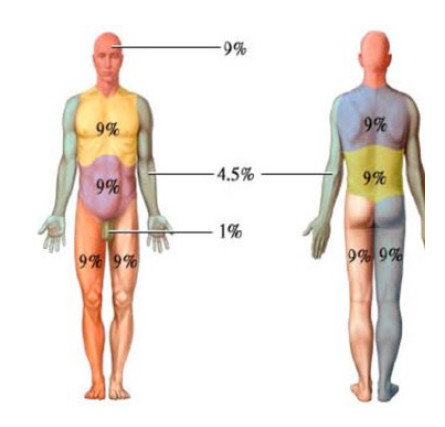Burns
Before continuing see the note on the use of this Guide
Clasification:
It can be caused by fire, hot objects, electric shock, sun exposure or chemical substances (acids, abrasives, etc.)
Burns are classified according to the damage caused to the skin:
- First degree: only affecting the outermost layer of the skin causing redness, inflammation and pain (they are less than 5-7 cms.). Even blisters can form.
- Second degree: they are more extensive and deeper (greater than 5-7 cm), affect several layers of the skin. They usually present blisters.
- Third degree: damage all layers of the skin, even the deepest tissues such as muscles. They may have a whitish, dark or charred appearance with a feeling of swelling.
First Aids:
In first-degree burns apply cold water for at least 5 minutes to lower the temperature of the tissues.If you do not have running water you can apply a cold compress with a wet towel or clean cloth. Do not apply any other home remedy. After applying the water, it can be bandaged with a sterile gauze without tightening too much.
- Do not apply any home remedy or ointment unless a doctor tells you to.
- Do not apply ice.
- Do not burst the blisters, it is a means that the body uses to lower the temperature.
- If you have burned on a ring finger, try to remove it before the finger becomes inflamed.
In second or thrid degree burns do not follow the above measures. Call emergency services immediately (911). Check the condition of the victim, that his breathing is regular, that he does not suffer bleeding; evaluate the state of consciousness. In each case follow the necessary measures. Do not apply magnets. Wait for emergency services to come.
Evaluation:
It is also important to determine the percentage of injured skin, for which the following parameters are followed:
- head: 9%
- thorax: 9%
- anterior upper limb: 4.5%
- posterior upper limb: 4.5%
- abdomen: 9%
- high back: 9%
- lower back: 9%
- genitals: 1%
- anterior lower limb: 9%
- posterior lower limb: 9%

The burns require urgent medical attention in case of: second degree burns that affect more than 20% of the body (10% in children). Third degree burns that affect more than 10% of the body (5% in children). Also should be attended by medical personnel when they affect areas of the face, genitals, hands, feet or joints. Especially dangerous are the burns of the respiratory tract due to inhalation of smoke, vapors, very hot gases or toxic substances, you should immediately go to a medical unit as they can quickly compromise the ventilatory capacity.
To all the above considerations we must add other factors such as the general condition of the victim: pregnant women, children, diabetics, immunosuppressed, cancer patients ... all of them are at greater risk.
Prevention
The burns throw thousands of victims annually, either for injuries that require hospitalization, often with irreversible effects; and in other cases resulting in death. The burns can be prevented, we must pay special attention to the little ones, who are the ones most exposed to suffer such accidents. Let's look at some of the preventive measures:
- Do not get distracted when using the stove or oven.
- Keep the handles of the pans and pots towards the center of the stove.
- Prevent babies and toddlers from approaching the stove and other sources of heat or fire.
- Keep lighters and matches out of the reach of children.
- If you have babies or toddlers, cover the electrical outlets.
- Keep hot drinks or other liquids out of the reach of children.
- Always check the temperature of a liquid or food before giving it to the little one.
- Use with caution the devices that produce heat such as bread toaster, heater or iron.
- Teach older children the risks of burns and how to prevent them.
- Avoid prolonged exposure under sunlight, even using sunscreen creams (read instructions carefully).
- Ask a technician to check the electrical installation of the home periodically.
- Avoid using electrical appliances in poor condition.
- Check that pets do not play or chew the electric wires.
- Install safety equipment such as fire alarms and fire extinguisher.

